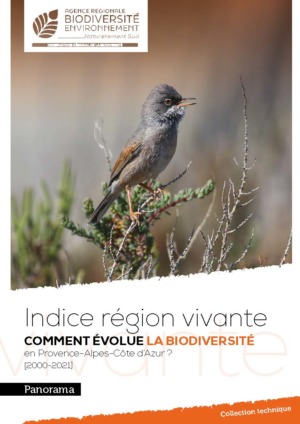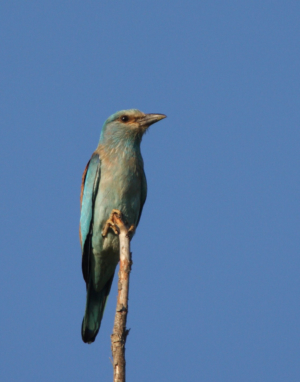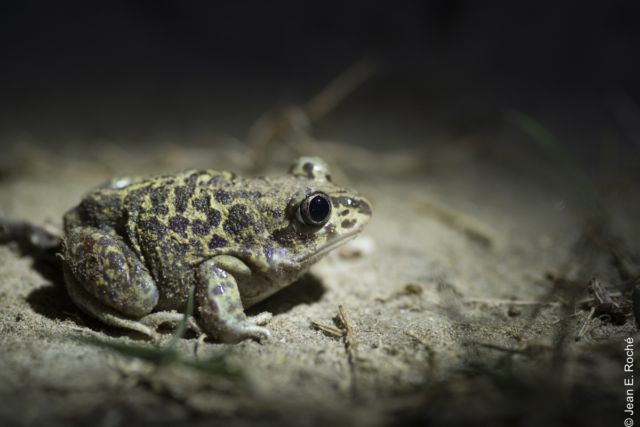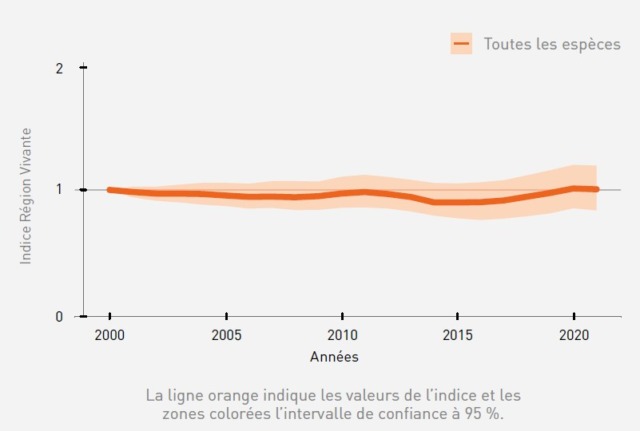The decline in biodiversity in Provence-Alpes-Côte d’Azur is not inevitable! The Indice Région Vivante 2000-2021 publication takes an assessment of the situation in the region and urges us to redouble our efforts.
Co-developed with the Tour du Valat, the Provence-Alpes-Côte d’Azur Regional Agency for Biodiversity and the Environment (ARBE) has published an update of the Living Region Index, in close collaboration with the Southern Region, the DREAL and the OFB’s inter-regional directorate, and with the contribution of numerous partners carrying out naturalist inventories.
 [1]The Living Region Index measures the state of biodiversity in the region. It is a reference indicator that can be used to measure the impact of the pressures at work, particularly climate change, as well as the public policies implemented to preserve this biodiversity that is so vital to mankind. The Southern Region is the first and currently the only region to have introduced this indicator. Other regions such as Grand Est and Bourgogne Franche Comté are following suit.
[1]The Living Region Index measures the state of biodiversity in the region. It is a reference indicator that can be used to measure the impact of the pressures at work, particularly climate change, as well as the public policies implemented to preserve this biodiversity that is so vital to mankind. The Southern Region is the first and currently the only region to have introduced this indicator. Other regions such as Grand Est and Bourgogne Franche Comté are following suit.
Click here to download the publication. [1]
How has biodiversity evolved in Provence-Alpes-Côte d’Azur over the period [2000-2021]?
The results show an average trend of stable population growth for the 325 vertebrate species monitored, but with contrasting situations depending on the species and the environment:
Species
- 45% of species are increasing (Griffon Vulture, Great Egret, Alpine Ibex, European Roe Deer, White Stork, European Roller, Eurasian Spoonbill, etc.).

- 41% in decline (European eel, Black swift, Purple heron, Little owl, Common pochard, Ocellated lizard, etc.).

- 14% have no clear dynamic.
Environments
- Trends appear to be declining in agricultural and marine environments. For the latter, the overall decline across the Mediterranean outweighs the positive results from marine protected areas, where Corb and Rouget populations are improving.
- The situation has stabilised for rivers and wetlands, where many waterbird species are doing better, but aquatic environments remain particularly fragile and vulnerable in the current climate of global warming.
- The situation appears to be more positive for forest species, but this needs to be confirmed with more monitoring.
For the 4 geographical sectors where a trend could be obtained
- Preserved coastal ponds and marshes appear stable
- The region’s coastline – apart from the preserved natural areas that benefit species – remains subject to the pressures exerted by man and his activities.
- Trends appear to be more favourable in the Provençal and Alpine massifs.

Conservation and management efforts that are paying off
The results testify to the positive impact of regulations and protection and conservation actions. Regional and national policies have provided the region with a rich and diverse network of protected areas (with examples of rather strong protected areas: 4 national parks, 10 national reserves, 7 regional reserves in 2021).
Action is being taken to implement the National Biodiversity Strategy, which has been in place since 2014, in particular the national protected areas strategy and the national action plans for endangered species. Action is also being taken as part of the regional climate plan “Gardons une COP d’avance” (Let’s keep a COP ahead) with the support of the regional nature parks and the deployment of regional reserves, but also through support for actions to restore environments and preserve species.
The preservation of habitats and the implementation of management measures benefit certain species: their regional numbers are stabilising or increasing.
> The measures implemented in wetlands (which account for 6% of the region’s territory) appear to have been beneficial, particularly for waterbirds, whose numbers are now often on the increase, after having fallen to their lowest levels in the 20th century.
Pressures still weighing heavily on regional biodiversity
However, the results show that species and environments are still subject to considerable pressure, which means that efforts need to be continued:
- Aquatic environments are becoming increasingly vulnerable in the current climate of global warming, where reduced river flows, increasingly early and long dry periods observed in Provence-Alpes-Côte d’Azur, disruptions to ecological continuity and water abstraction are disrupting and threatening aquatic life. As a result, 6 species of amphibian, such as the Cultivated Pelobate, and 8 species of dragonfly and damselfly, such as the Blue Agrion, are threatened with extinction on the regional red lists, and 15 species of freshwater fish, such as the Rhone Apron and the European Eel, which are present in our region, are on the national red list.
- The significant decline in the number of birds in agricultural areas in Provence-Alpes-Côte d’Azur since 2003 is alarming. Agricultural land accounts for 16.3% of the region’s surface area (source: BD OCSOL 2019), but this area shrank by 2,627 hectares between 2014 and 2019 (source: BD OCSOL 2014-2019, consumption of agricultural land larger than 1 hectare), and continues to be used for housing, business and commercial zones, or for the construction of ground-based photovoltaic farms, thereby impacting the vertebrate species that live there. Agricultural intensification (chemical inputs, reduction in uncultivated areas – such as hedges – at the edge of fields, etc.) is also having an impact on biodiversity.
- Despite positive and localised results, the sharp decline observed is a warning about the fragility of the marine environment. The abundance of vertebrate populations has fallen by 52% in pelagic and coastal ecosystems over the last 25 years (source: Méditerranée Vivante report, Tour du Valat). At least 78 marine species assessed by the IUCN are also threatened with extinction, including cartilaginous fish, marine mammals and corals (source: Plan Bleu). The pressures on marine species are numerous and well known: degradation of their habitats such as shallow waters, Posidonia meadows and coralligenous reefs by coastal development, boat anchors or fishing drags, overexploitation, pollution and non-native species favoured by the warming of marine waters, some of which can have negative effects on ecosystems. Rising water temperatures also threaten the least tolerant species, causing mass mortality of invertebrates (gorgonians, sponges) as in the summer of 2022.
- On some sites, the increase in human visits has become an increasingly important issue since the health crisis, exerting pressure that impacts the environment and biodiversity (trampling of flora, disturbance of fauna, erosion of the environment, risk of fire).
- Climate change, which is more marked at higher altitudes than on the plains, is undoubtedly a major constraint on high altitude environments and increases the vulnerability of the cold-affinity species that live there.
The Living Region Index, a unique decision-making toolThe Living Region Index (LRI) is an adaptation for the Provence-Alpes-Côte d’Azur region of the Living Planet Index, an international benchmark created and developed by the WWF in 1998. An initial LRI was produced in 2017. This new overview completes the collection of indicators and tools for understanding our biodiversity, developed as part of the Regional biodiversity observatory run by the ARBE since 2011, and co-directed with the South Region, the DREAL and the OFB’s inter-regional directorate. Its aim is to make information on regional biodiversity available and accessible, so that public authorities and the general public can better understand the issues surrounding biodiversity loss. This index invites all stakeholders to take action to halt the loss of biodiversity by limiting land artificialisation, pollution, the development of invasive species, the excessive use of natural resources and the impact of climate change. |
